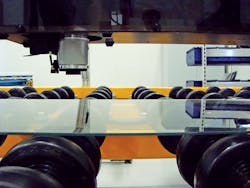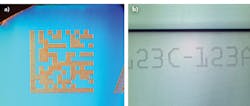Laser allows single-step marking on automotive glass
Methods streamlines unique identification and serialization process
DAVID BENDERLY
Lasers have touched many segments of the auto industry, including metal cutting of chassis, welding of components, and selective removal of opaque material to reveal illumination on day/night displays. It is hard to imagine today's car without lasers playing a role in their manufacturing. One of the contributions is laser marking of glass—for example, on car windshields (FIGURE 1).
During the windshield production process, marks are used to track progress, identify components, and provide a stream of traceability for regulation and compliance in high volume (FIGURE 2). Essential for both identification and security, the marks found on windshields provide a wealth of information regarding manufacturing operations. Typically, windshield marks identify the name of the car manufacturer; the name/logo of the glass manufacturer; the brand name of the glass; the American Standard (AS) number; the position in which the glass may be used; the model number; the Department of Transportation (DOT) code for the US or an E code (indicating country) for European cars (assigned by the United Nations Economic Commission for Europe); glass type; and the month and year of production.
Part of what makes glass marking complex is that each windshield, or batch of windshields, has variations on inscription information. Because marks identify the windshield manufacturing month, the inscribed information must be constantly adjusted. Lasers are highly efficient and uniquely suited for quick changes in inscribed data.
Glass, a noncrystalline amorphous solid, is commonly transparent to visible light. Lasers can be used to produce a contrasting mark that appears white, frosted, or slightly darker on glass by introducing a structure that diffracts light or changes the refractive index of glass, modifying its optical properties (FIGURE 3). Being a brittle material, it is important that the process itself does not introduce stress that could lead to failure of the substrate, although microfractures may be acceptable if the surrounding material is not affected. The two areas where glass is marked are the surface and subsurface, each with their own benefits, relevant technologies, and associated methods.
Surface marking
Traditionally, sandblasting and chemical etching were the methods used for marking windshields before lasers were commercialized. In these processes, a decal is used to protect the glass, leaving an opening where the acid comes into contact with the glass. Acid etching—for example, using hexaflurosilicic (H2SiF6) or hydrofluoric (HF) acids—creates a translucent surface, whereas sandblasting (i.e., "abrasive blasting") mixes high-pressure air with an abrasive material that cuts away at the glass surface, creating a frosted effect.
Printing is another surface marking method that is still commonly used on windshields, which can incorporate the use of lasers, for instance, with laser bonding. Laser bonding is an additive process involving the bonding of a material to the substrate surface, using the heat generated by a laser. The materials used in this process generally consist of a glass-frit powder or ground metal, oxidized and mixed with inorganic pigment and a liquid carrier (usually water). In this method, the ceramic particles absorb the laser energy, which melts and fuses the glass frits with the additional coloring from the metal oxides' pigment. The advantage of this method is the ability to achieve a high-resolution, high-contrast mark. Because of the chemical bonds created during the fusing process, the mark is considered permanent. The pigment can be painted or sprayed onto the surface to be marked, or transferred via pad printer, screen printer, or coating roller. Laser bonding can also be performed with ink foils, which is accomplished using heat levels that have no noticeable effect on the glass substrates and are safe for use in safety-critical applications.
Multi-step and labor-intensive, sandblasting and chemical etching methods leave marks lacking in crispness, and go hand in hand with recurring operator inaccuracy. Preparation of masks is required, as harsh chemicals are used. By marking before the washer, it is also harder to make production changes; therefore, marking batches by date becomes an inefficient endeavor. When compared to acids, lasers also environmentally friendly because there are no dangerous byproducts, and they prevent the need for storage, handling, and disposal of acids.
Laser interaction with glass is complex: careful selection of laser parameters, such as wavelength, pulse duration, beam quality, and power, will produce a very different type of mark. To produce a contrasting mark, the laser must produce selective change to the glass in the radiated area. This can be either a surface or subsurface change.
The traditional laser used for many years to mark glass products is the CO2 laser, available in either 10 or 9μm wavelength. These far-infrared lasers use a highly thermal process, which produces a mark by controlled selective microfracturing of the glass. The long wavelength is mostly absorbed at the surface.
By both evaporating and fracturing the glass as it rapidly cools, a high contrast mark can be achieved, as microfractures alongside newly created surface roughness diffuse light. Done correctly, stress and microfracturing could remain limited to the exposed area only. A second laser pass at lower energy could be used at times to fuse and anneal the mark, preventing further fracture from residual stress.
Deep-UV lasers have also entered the auto glass-marking arena. Although glass is transparent to visible light, it does exhibit good energy absorption in the UV range. This allows the UV energy to be absorbed in the glass surface, such as in the 193nm of the excimer lasers, as seen in PhotoScribe Technologies' LMS-650XS (FIGURE 4). The marking process is considered to be a photo-ablative nonthermal process, which is sometimes referred to as "cold ablation" or "cold laser" marking.
Another surface laser marking method incorporates digital printing technology, which uses a carrier foil coated with ink or fusible contrasting material. In this method, a laser beam fuses ink from the foil and prints directly onto the glass substrate. Advantages of this technology are a single-step print process, pristine marks, and multiple print options (silver or black, for example).
Windshield surface marking could be conceived with another method as well. All glass in production can be pre-coated with a sacrificial metallic layer (done by, for example, sputter coating). This layer is then selectively removed with lasers, leaving a metallized layer in the shape of the desired indicia or marking. The laser removes the metallized layer without any impact on the glass, leaving it perfectly clear and opening the door to marking in an array of metallic colors.
Subsurface marking
Extreme short-pulse laser subsurface marking creates marks without disturbing the surface of the glass windshield. It can only be done with wavelengths that have relatively low absorption in glass. From our experience, roughly between 350nm to 1μm wavelengths produce the ideal mark. Within the range, the laser is focused subsurface with an energy level below the threshold of ablation throughout the beam path, reaching ablation level only at the focal point. This can only be achieved with clear glass that has good surface quality. Subsurface marking on thermally toughened glass, also known as safety glass, is particularly receptive to stress. In the past, the drawback of this technique was that it could cause stress in the glass, leading to fractures or, in a worst-case scenario, complete breakage. To add further complication, such fractures could appear hours or even weeks after laser marking was done, making quality control difficult. Today's modern lasers, however, can make subsurface marks safe.
Surface marks can be ground out. In contrast, subsurface marks are desirable because they cannot be modified, providing greater security.
Diffractive optic element marking
The latest development of extreme short-pulse duration lasers in the femtosecond regime opened the possibility of marking, or modifying, the refractive index of glass without any collateral damage (FIGURE 5). Femtosecond lasers can produce nano- and microstructures that diffract light, presenting a color effect. These structures are in the scale of visible wavelength. Laser marking with a femtosecond laser produces color by creating a diffractive optical element in the physical structure.
Laser systems have an advantage over other methods by being a single-step process and a flexible solution. Laser beam steering is computer-controlled and the information to be inscribed could be modified in real time. It allows for unique identification and serialization. The user interface maximizes time efficiency with minimal setup when changing out logos and text, as well as setting up laser orientation. Masks and consumables are not required, cleanup is minimal, and no waste material is produced. Lasers provide an option for marking glass windshields that has streamlined the automotive manufacturing production floor.
DAVID BENDERLY is CEO of PhotoScribe Technologies, New York, NY; www.photoscribetech.com.





